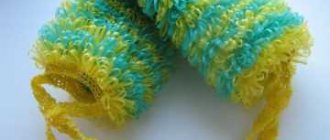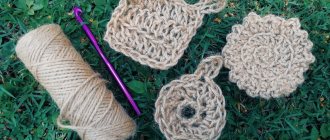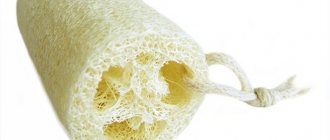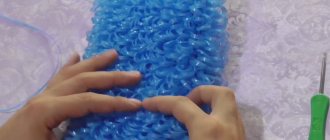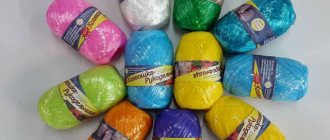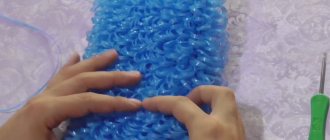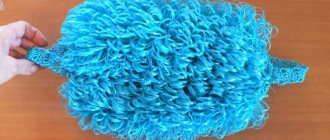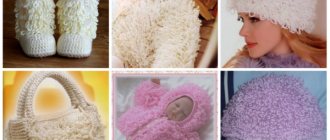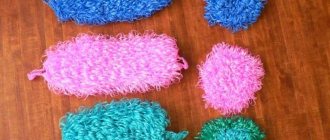Everyone uses washcloths. Mostly they are bought, but due to the fact that washcloths stretch quickly, it is not entirely profitable. Today we will talk about how to knit a shower sponge using a hook with difficult elongated loops or regular ones - it takes little time, and the costs are significantly reduced. Our master class today is dedicated to this very topic.
- MK for beginners on crocheting washcloths according to patterns
- Let's look at the step-by-step instructions with a description of the work
- We create a washcloth-mitten with our own hands from a photo
- Step-by-step instructions for creating a shower product
We strongly recommend watching the training video.
Making useful things for everyday life with your own hands is a very good hobby!
How to knit a washcloth? Basic moments
The process of knitting a washcloth includes a number of stages:
- The choice of material for the washcloth.
- Selection of knitting tools.
- Choosing the shape of the washcloth.
- Directly knitting a washcloth.
Let's look at these steps in more detail.
Which tool to choose for knitting a washcloth
Knitting washcloths can be crocheted or knitted. Both options make it possible to realize any idea and knit a washcloth of any size and shape.
The choice is based on personal preferences and skills, if you know how to crochet, then knit with it, if knitting needles are closer to you, then choose this method of knitting. As a rule, the product is knitted faster, but most people use a crochet hook.
If you have never knitted before, it is preferable to start with a hook; it is easier to work with than with knitting needles.
Washcloths for a bath should be knitted loosely, without pulling the thread too tightly. This is necessary to make the washcloth flexible and soft. If you want the washcloth to foam better and be even softer, you can insert a piece of foam rubber into it.
What material to choose for knitting washcloths
Today you can see in stores washcloths made of different materials, differing in hardness, durability and other properties. The most common option is hand-knitted polypropylene washcloths. These are what grandmothers sell at the market.
Polypropylene is a cheap, wear-resistant material that perfectly retains its shape and has good rigidity, which makes it possible to efficiently remove the stratum corneum of the skin. Polypropylene thread can be easily found in any craft store; the color range of such yarn is huge.
The disadvantage of polypropylene is that it is artificial, therefore it can cause allergies and is not suitable for people with sensitive skin.
Do you prefer washcloths made from natural materials? Pay attention to the bast - fibers extracted from the inside of the linden tree. This material makes durable and environmentally friendly washcloths. They cleanse the skin well and have a beneficial effect on the body thanks to the phytoncides released when the fibers are heated.
A well-known and popular material for washcloths is loofah. For its production, fruits of the pumpkin family are used. Loofah is tough and can be used to effectively scrub the body, removing all dead cells. Loofah washcloths are especially popular among women, as they are good helpers in the fight against cellulite.
Sisal, a material made from the fibers of tropical plant leaves, will help get rid of orange peel and effectively cleanse the skin of impurities and dead skin layers.
If we return to the origins and traditions of the Russian bath, we suggest paying attention to flax. This material is perfect for washcloths; it has high strength, long service life, environmentally friendly composition, a pleasant aroma and has a healing effect on the body.
Want a little exotic? Pay attention to the ramie washcloth - Chinese nettle. It has medium hardness, so it is suitable for any skin type. Thanks to the substances contained in the fibers, the washcloth has an anti-inflammatory and rejuvenating effect.
Selection of materials
Before you start knitting a washcloth, you need to decide on the type of thread and hook size. For production you will need:
- Nylon or polypropylene thread, sisal or natural linen. When choosing a material, you should focus on your own taste preferences. To make a washcloth you will need approximately 300 g of yarn. You need to pay attention to rigidity: the material should not be too soft or too hard. It is necessary to find a “golden mean” so that the product does not scratch or iron, but rubs. In addition, the material should not be twisted; the thread should be even. Often, experienced needlewomen, when choosing a material for a washcloth, give preference to medium-thick polypropylene, which can be purchased not only in special craft stores, but also in hardware departments. Threads need to be taken with a reserve.
- Hook marked from 3 to 5. The thickness of the tool depends on the threads. It is better to give preference to a metal product that does not have a very sharp head, otherwise it will interfere with the work, delaminating the thread.
How to knit a mitten with a washcloth
Any synthetic or acrylic thread is suitable for this work. Hook number 2.0-2.5. Approximate yarn consumption is 80-100 grams.
Crochet a washcloth mitten
Let's consider knitting a washcloth mitten made of synthetic material, 400 m/100 g thick, orange. The number of loops cast on is determined by the girth of the hand, the thickness of the thread and its shrinkage when wet. Focus on the range of 45-60 loops.
The washcloth is knitted by alternating rows of single crochets with rows of elongated loops.
So. The number of loops in the described product was taken to be 50, hook 2.5. We collect a chain of air loops and close them into a ring. Next we knit in a circle. We knit a couple of rows with single crochets, then begin to alternate rows. The result is a “terry cloth”. In this way, the desired height to the thumb is knitted, approximately 5 cm.
In the area of the thumb we leave 10 loops unknitted, instead we cast on 10 chain loops. Next we knit in a circle using the cast-on chain stitches up to the little finger. Then we begin to decrease the loops evenly, knitting two loops together through three or four loops. This is how the glove is rounded. When 4-6 loops remain, tighten the edges.
Using the remaining loops, we knit the thumb in the same way as knitting a washcloth by alternating rows. The edge of the washcloth is knitted with 2-3 rows of single crochets, with a slight decrease in loops, reducing the volume (if necessary), forming a kind of “elastic band”. In this case, a loop is formed in the last row with a chain of 10 air loops.
The mitten is ready.
Source
Video lesson:
The yarn used is double, hook number 5. First of all, 36 chain stitches are cast on, they are connected with a ring, and a row is knitted in single crochets. In the next row, only single crochet stitches are used, then two more similar rows are knitted. Let's start creating the main pattern.
A cone is formed from three yarn overs knitted together. Two stitches are skipped, and another cone of four yarn overs is knitted. The entire row is formed from such cones. This pattern with cones is repeated from row to row. A washcloth made of cones arranged in a checkerboard pattern ends with a cuff made of rows of single crochets.
Crochet washcloth-mitten
A washcloth-mitten or kese is a convenient accessory that is often used not only in the bathhouse, but also in the hammam. It is easy to use and great for self-massage.
The difficulty of knitting a washcloth-mitten is that you need to knit your thumb in the product; if such a nuance scares you, then you can make a washcloth without it.
To knit a washcloth-mitten you need:
- Cast on a number of loops equal to double the circumference of your palm at the widest point with a small margin, because then when knitting the next rows, the length of the first will decrease slightly.
- Connect the braid into a ring using a connecting post.
- Continue knitting the selected pattern for 15 rows.
- On the 16th row, knit in a pattern to the place where the thumb will be, there you need to knit 15 chain loops and close them into an arch, skipping 15 loops from the previous row. Then knit in the usual pattern until the end of the row.
- Work 10 more rows or until pinky is covered.
- In the next rows you need to start decreasing, do them every three columns until the last one remains, after which you need to make a knot and cut the thread.
- Knit 7 rows in the thumb area with a pattern, then start decreasing every three stitches.
- Knit a loop of air loops so that the washcloth can be hung.
DIY mesh washcloth
DIY mesh washcloth
Vegetable mesh is soft and therefore suitable for creating a washcloth. You can take a new mesh on a roll, but a used one will also work. DIY mesh washcloth:
- Wash the mesh after use (if you have a used mesh), and dry
- Cast on 10 mesh loops on the knitting needles and knit according to the “ribbon yarn scarf” principle. The loops should be loose and not tight
- You will get several rows of purl stitch.
- Then roll the product into a ring and secure the knitting with a hook or needle and thread
DIY washcloth made from new mesh
Kese washcloth
Kese washcloth
In the Turkish baths - hammam, they use soft washcloths in the form of mittens made from sheep's wool. You can sew a kese washcloth yourself:
- Take a piece of sheep's wool. If there is no such material, you can use any other, but soft and delicate texture
- Cut out two parts so that the finished washcloth can be easily put on your hand
- Sew these parts and trim with binding
- Make a handle - the washcloth is ready
How to knit a washcloth mitten
We will knit two identical triangular fabrics, sew them together, leaving room for the thumb (we will tie it at the end).
We dial 40 v.p. + 2 v.p. rise.
12 rows - double crochets (straight and reverse rows). We start each row with 2 ch. rise.
Decreases
2 v.p. lifting, 1 st.s/n, skip 1 column. And symmetrically at the end make the same decrease: skip one column, 2 treble crochets.
Making such decreases by skipping two columns in each row (at the beginning and at the end) diagonally will be more beautiful.
That is, 2nd r. decreases: 2 ch. lifting, 2 treble s/n, skip one column. At the end of the row, the same decrease is symmetrical.
3 r.: 2 ch. lifting, 3 treble s/n, skip one column.
Knit in this way until the diagonals of the decreases converge into one column in the middle.
Next are two rows - double crochets.
Knit the second fabric for the washcloth in the same way.
Sew them together on both sides, leaving room for the thumb (try it on as it will be more convenient).
Along the perimeter of the hole, crochet single crochet stitches and knit 3 rows in the round. Then make one decrease in the same place in each row - just skip one single crochet until the finger is completely closed. Pull the remaining loops together with a needle and fasten to the wrong side.
Assembly
The washcloth mitten itself is quite spacious. We did this on purpose. Now let’s try it on our hand so that it doesn’t dangle, but also doesn’t put pressure.
We knit 6 rows around the perimeter of the washcloth using single crochets.
From the outside (depending on which hand you will put it on), turn it over and sew it on the front side (just make a couple with a stitch with a needle).
Tie a loop of chain stitches.
A crocheted washcloth mitten with elongated loops is knitted according to the same pattern, only instead of double crochets, knit single crochets with elongated loops.
How to knit a loop
Source
Round bath product
Those who like going to the bathhouse will appreciate the practical bar that fits comfortably in the hand. Linen or sisal are often used to make bath washcloths .
You can knit in any design you like: fluffy, oval or round. Knitting a round product does not require any supernatural skills. Step by step description:
- Knit 7 chains, which are then closed in a circle.
- Continue knitting rows with a single crochet.
- The size of the product will increase during knitting. When the washcloth reaches a diameter of 20 cm, begin contractions in each row.
- Work 5 more rows in this way. As a result, the swimwear will look like a bowl.
- Place a foam circle in it and attach a handle. You can decorate this product to your liking.
Step-by-step master class on how to knit washcloths and mittens with elongated loops
Be sure to practice knitting elongated loops before you start knitting the product itself. The instructions, extremely simple and ideal for beginners, sound like this:
- We put a chain of air loops on the hook.
- We knit 3 rows in a single crochet stitch.
- We knit a chain loop, then a single crochet.
- Insert the hook into the previous strip and knit a loop.
- Picking up the working twine from below, we make a large ring.
- Insert the hook into the loop of the base.
- We pick up the twine again and pull it through 3 loops.
Now we will learn how to crochet washcloths and mittens using elongated loops. In order to knit the product correctly, you must follow the instructions exactly without skipping steps.
- We begin knitting by knitting a series of “air” loops in a circular manner. Please note that the size of your future washcloth will depend on the size of the ring. The standard size is 40 loops. The height of the product must be determined independently.
- Single crochet we knit seven rows in stitches.
- On the next strip we knit elongated loops.
- We complete the work as follows: two chains of air loops, then you need to connect them into a ring. As a result, we get two washcloth handles.
- We turn the washcloth with the elongated loops outward.
- Our product is ready! Please note: before using a washcloth, you need to wash it and pour boiling water over it to make the product softer.
Materials for knitting washcloths and their features
Before you start knitting a washcloth, you should choose for yourself what material it will be made of.
Natural ones themselves do not last long enough, as they are a favorable environment for the habitat and reproduction of pathogenic bacteria. Their service life is no more than 30 days. The same cannot be said about synthetics - their service life is about 90 days. At the same time, everyone can choose the material at their own discretion and preference.
- Cotton or linen threads
Perfect for children's, sensitive or irritated skin, as cotton itself is a very delicate and soft material.
To increase blood circulation, flax washcloths are suitable.
- Polypropylene twine
Durable synthetic material, foams well. Excellent for knitting with elongated loops.
Easily removes fatty, sweaty skin cells and removes dead skin cells.
For reference! You can also use twine made from natural materials (jute, linen).
- Sisal threads
For rough and hard skin. Used for making flat washcloths for massage.
Sisal toy washcloth
- Viscose
An artificial fiber from which very dense, high-quality and quite beautiful products are obtained.
- Acrylic threads
The reliability, strength and perception of this material are practically no different from viscose. It's just that different materials are used in production.
Accessories made from acrylic threads
- Polyethylene bags
This method of using bags is environmentally friendly and utilitarian. Washcloths made from bags are perfect for sensitive and delicate skin.
You might be interested in Making your own rag doll
Attention! This type of bath attribute is not suitable for using scrubbing products.
- Textile bags, nylon (women's tights), etc.
If you don’t have yarn, you can try to create something from scrap materials. This could be old women's tights, used flour or sugar bags, clotheslines, etc.
Turtle made from nylon tights
The crochet hook is selected directly to the thickness of the thread. You should not choose one with a sharp tip, since the threads are mostly multi-layered and will fluff, so the hook should be smoothly rounded.
How to choose threads for knitting washcloths
Threads come in different thicknesses. The thicker the thread, the tougher the finished washcloth will be. Select threads of such thickness that it is convenient to use them for crocheting No. 3-4. Although the most delicate and soft washcloths are crocheted No. 2, i.e. thin threads. Some people like washcloths that are harder and denser, while others like them softer.
Buy bright threads to match your bath accessories. For children, it is better to knit a washcloth from thin threads in the shape of a mitten or a funny animal.
Before the first use, be sure to keep the washcloth in boiling water for 5-7 minutes, the washcloth becomes pleasant to the body and lathers well.
Which yarn won't work?
Mohair, angora - all “fluffy” threads. To knit a washcloth, it is better to take non-fluffy yarn that will not deform if it comes into frequent contact with water.
What shape to knit a washcloth
A washcloth with elongated polypropylene loops can be knitted in the form of a pipe in a circle. It is convenient to insert foam rubber into such a washcloth.
- You can knit a flat rectangular washcloth according to the usual pattern using single crochets (only every third row is knitted with elongated loops):
- The crocheted washcloth can be oval-shaped (in this case, every third row is also knitted with elongated loops):
- A washcloth can be crocheted in the form of a mitten with or without elongated loops:
- Round washcloth (do not forget to knit every 2 or 3 rows with elongated loops):
- A washcloth for a child can be crocheted in the shape of any toy with elongated loops.
There is one more nuance: the longer the elongated loops, the softer the washcloth.
How to knit elongated loops:
If you have never knitted with elongated loops, then you should first try to knit a sample from simple threads in order to practice and work out the tightness of the knitting. The fact is that you need to knit tightly with long loops, i.e. Tighten each loop with columns so that the fabric is not loose. It will be especially difficult for beginners to immediately knit elongated loops from polypropylene threads.
Knitting patterns for elongated loops (choose the one that most understands you):
Knitting elongated loops on a ruler:
Beautiful funny DIY bath sponges
One of the brightest and cutest is the bunny washcloth. It is knitted using the elongated stitch technique. To begin, dial 20 cm VP. Connect them into a ring and knit 2 rows of sc.
- Start knitting the “hairy” part. Knit 2 rows of sc.
- Now you need to make a cone; to do this, pass the previous element through 2 sc. That is, for every 3 elements of the previous row you must knit only 2
- Knit until all the loops are connected at one point. Decorate the face, tie long ears and a tail
Knitting a washcloth-mitten
For knitting creative washcloths, it is preferable to use natural materials. It can be cotton, sisal or linen. Synthetic yarn will also work.
Step by step knitting:
- You should start with a chain, the length of which is determined by the size of your hand.
- Knitting goes in circles. Single crochets are used.
- Fabrics for fingers (or one finger) are also knitted in a circle.
- For a child, a knitted mitten is designed in the shape of some funny animal. How to do this is shown below.
Sisal washcloth
Sisal washcloth
Sisal is a natural fiber that is obtained from the leaves of Agava sisolana. Needlewomen willingly make washcloths from it - for massage and for washing.
How to do it - steps:
- The sisal washcloth should be flat
- To create it, cast on 30 loops and knit or crochet in any pattern. You can even use stockinette stitch if knitting, or single crochet if crocheting
- Fold the edges, first inserting handles from an old washcloth, and sew. You can simply sew handles knitted from the same threads
Washcloth-mitten with elongated loops: detailed MK
A washcloth and mitten are knitted using the same principle. Select the sizes according to your hand - the starting chain of air loops should freely cover the hand (there should be a little free space left, since a wet mitten is difficult to put on). How to knit a washcloth-mitten - read on.
First of all, knit a chain of air loops and connect it into a ring. At the same time, make sure that the chain does not turn over and form a figure eight. Next we knit two rows of single crochets.
Knitted a chain, connected it into a ring
Knitted two or three rows with single crochets
Next, we begin to knit long loops. Only this time we will use a different technique - the loops will be on the front side. Knit a single crochet, using the thumb on your left hand to pull off the thread.
Pull the thread with your left thumb
Hook it near your index finger and then knit it like a regular single crochet.
Having hooked it, we pull it under the jumper
Got two loops on the hook
Two loops tied together, only one left
Then we repeat again - we pulled the thread, grabbed it, pulled it under the jumper, and made one out of two. And so on until the end of the row.
Row with air loops
We make the next row from single crochets. So we alternate (loops-posts) to the height where you need to make a hole for the thumb.
Approximately this piece is needed before the beginning of the thumb
Then, when knitting a row with posts, in some place we knit 12 chain stitches, skip the same number of jumpers in the row and tie them to the 13th. We finish the series. This creates a hole for your finger.
Chain of air loops
This is how it will be
Next we knit as before, alternating single crochets with elongated loops.
A couple of rows are knitted
We continue until the little finger is closed.
Little finger closed
The mitten-washcloth is almost crocheted. Now in each row we decrease several loops. So - until the last one remains, close it, cut the thread.
Thumb wrap
Next we knit the thumb area. We start with a row of single crochets and alternate it with elongated loops. When the thumb is closed, close the loops in several rows.
The final touch is the top binding and eyelet. Crocheting a washcloth mitten is finished
The final touch remains - to tie a loop through which you can hang the knitted washcloth. You can make two or three more rows of single crochets, and make a loop in the last one.
This washcloth is good for massage and exfoliation.
Source
Crochet washcloth-mitten video
Children's washcloth toy
A crocheted washcloth (step-by-step instructions for beginners are presented below), crocheted in the shape of a hedgehog, will not be difficult if this pattern is used when knitting.
Knitting step by step:
- To start knitting, you should knit a chain of 32 chain stitches and connect the first and last loops.
- The first 2 rows are knitted with single crochets.
- Then 30 rows are knitted with “fur” (in the manner described above).
- To knit the muzzle you will need white. 5 rows are knitted with simple stitches, after which 4 loops should be decreased in each row.
- The thread is cut and secured. The eyes and nose are decorated with threads of the main color using a needle.
Berry-shaped washcloths also look gorgeous.
Ready-made knitted washcloths and mittens: photos, assortment, prices
If for some reason you cannot/don’t want/don’t know how to knit items for baths and showers, you can buy washcloths and mittens on our website. The washcloths are knitted from polypropylene and natural yarn. Prices for washcloths and mittens depend on the complexity of knitting and the cost of yarn.
Here you will find several models of washcloth mittens that you can buy. Availability is indicated under each photo. Orders for knitting washcloths and mittens are not accepted. We sell washcloths that are in stock. The number of finished products is indicated under each photo.
Please ask all questions about purchasing ready-made handmade washcloths using the return form.
Original washcloth in the shape of a hedgehog
Despite its visual appeal, this sponge is rougher, because the original is made of polypropylene. You can experiment and knit it in soft yarn, however, we do not guarantee that you will be able to maintain the overall relief of the figure. In any case, a polypropylene hedgehog washcloth can act as a great hand-made gift or even just as a bright accessory in the bathroom.
Knitting a hedgehog begins with an air chain - a loop for hanging a washcloth. We cast on 20 VPs, close them in a circle with an SS, and knit a sc on top. From the first VP, located at the SS, we raise 3 more VPs, sc + 32 VPs (for the hedgehog’s body), SS.
We continue to knit in a circular manner, knit rows No. 1-2 without increasing 36 RLS.
Row No. 3: we begin knitting elongated loops - “spines”, which can be either the same or different in the degree of “elongation”. To knit elongated loops, you need to insert the hook into the PR loop and knit according to the principle of a simple sc, while pulling out the loop, but not finishing the stitch. It turns out that there are 2 loops on the hook, in parallel we put the working thread on the thumb, we knit another loop from this loop, we get 3 loops on the hook, after which we knit all three loops at once so that they do not come apart. We knit the third row with 24 stitches with elongated loops + 12 sc.
Rows No. 4-30: knit in the same way.
Rows No. 31-35: start knitting with white thread, 36 regular sc.
From the 36th row we begin to decrease to decorate the hedgehog’s face, up to 32 sc in the row.
In rows Nos. 37-41 we continue to decrease by 4 stitches, in the end we get 12 sc.
Row No. 42: knit 12 sc with the main color of yarn.
Row No. 43: continue decreasing, skip one stitch, next. We knit RLS and so on until the end of the row, 6 RLS remain.
Row No. 44: decrease, as in PR, we get 3 RLS. We fix the SS.
Using blue (black) thread we embroider the eyes, nose and mouth. The hedgehog is ready!
